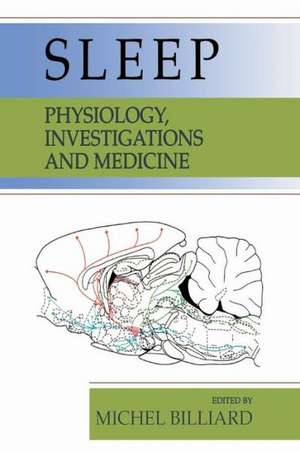Sleep: Physiology, Investigations, and Medicine
Editat de Michel Billiarden Limba Engleză Paperback – 29 oct 2012
| Toate formatele și edițiile | Preț | Express |
|---|---|---|
| Paperback (1) | 1436.57 lei 6-8 săpt. | |
| Springer Us – 29 oct 2012 | 1436.57 lei 6-8 săpt. | |
| Hardback (1) | 1442.77 lei 6-8 săpt. | |
| Springer Us – 29 sep 2003 | 1442.77 lei 6-8 săpt. |
Preț: 1436.57 lei
Preț vechi: 1512.18 lei
-5% Nou
Puncte Express: 2155
Preț estimativ în valută:
274.89€ • 287.73$ • 228.79£
274.89€ • 287.73$ • 228.79£
Carte tipărită la comandă
Livrare economică 31 martie-14 aprilie
Preluare comenzi: 021 569.72.76
Specificații
ISBN-13: 9781461349709
ISBN-10: 1461349702
Pagini: 788
Ilustrații: XX, 764 p.
Dimensiuni: 155 x 235 x 41 mm
Greutate: 1.08 kg
Ediția:Softcover reprint of the original 1st ed. 2003
Editura: Springer Us
Colecția Springer
Locul publicării:New York, NY, United States
ISBN-10: 1461349702
Pagini: 788
Ilustrații: XX, 764 p.
Dimensiuni: 155 x 235 x 41 mm
Greutate: 1.08 kg
Ediția:Softcover reprint of the original 1st ed. 2003
Editura: Springer Us
Colecția Springer
Locul publicării:New York, NY, United States
Public țintă
ResearchDescriere
The question about the function ofsleep remains one ofthe major challenges scientists are faced with. Wherein lies the fascination with sleep? I am convinced that it is the necessity for sleep. No one has failed to experience the overpowering urge to fall asleep after a disturbed night's sleep or after sleep was curtailed or deprived, especially when our daily activities impose restrictions on motor activity. The demand ofour body and brain to sleep challenges our understanding ofwhy this is the case, and which are the benefits ofa night ofprofound sleep. Also in animals prolongation of waking consistently increases their attempts to fall asleep. It has been stated that sleep is more necessary to animals than even food! The need for sleep and some insight into the consequences of the preceding daily waking activities on subsequent sleep was wonderfully formulated by Shakespeare in Othello: Not poppy nor mandragora, Nor all the drowsy syrups ofthe world, Shall ever medicine thee to that sweet sleep Which thou owed'st yesterday It is interesting that the most powerful single intervention which invariably influences sleep in a positive and predictable manner is the prolongation of waking. The activities which people or animals engage in during the wakefulness episode are secondary in the magnitude oftheir effects on sleep.
Cuprins
Part 1: Physiology of Sleep. 1. Normal sleep; C. Guilleminault, M.L. Kreutzer. 2. Normal sleep in children; D. Samson-Dollfus. 3. Neurobiology of the sleep-wake cycle; J. Adrien. 4. The major physiological functions during sleep; Y. Dauvilliers. 5. Models of human sleep regulation; D.G.M. Beersma. 6. Melatonin and sleep-wake rhythm; B. Claustrat. 7. Molecular genetics, circadian rhythms and sleep; Y. Dauvilliers, M. Tafti, E. Mignot. 8. Mental activities during sleep; J. De Koninck. Part 2: Diagnostic Procedures. 9. Polysomnography; A. Besset. 10. Ambulatory systems; T. Penzel, J.H. Peter. 11. Guidelines for visual sleep analysis; A. Besset. 12. Automatic sleep analysis; A. Besset. 13. Investigation of vigilance and sleepiness; A. Besset. Part 3: Disorders of Sleep and Wakefulness. A) Insomnias. 14. Insomnia: Introduction; N. Darchia, I. Gvilia. 15. A decision tree approach to the differential diagnosis of insomnia; J. Grenier. 16. Transient and short term insomnia; R. Peraita Adrados. 17. Primary insomnia; C.M. Morin. 18. Insomnia associated with medical disorders; M. Billiard. 19. Insomnia associated with psychiatric disorders; L. Garma. 20. Insomnia linked to medications; E. Corruble, D. Warot, C. Soubrie. 21. Benzodiazepines and new non-benzodiazepine agents; J.M. Monti. 22. Other medicationsused for insomnia; F. Goldenberg. 23. Insomnia in children: Clinical aspects and treatment; Y. Navelet. 24. Sleep and circadian rhythms in normal aging; J. Carrier, D. Bliwise. B) Hypersomnias. 25. Hypersomnias: Introduction; M. Billiard. 26. A decision tree approach to the differential diagnosis of hypersomnia; M. Billiard. 27. Insufficient sleep syndrome; M.S. Aldrich. 28. Medication and alcohol dependent sleepiness; D. Warot, E. Corruble. 29. Obstructive sleep apnoea syndrome and upper airway resistance syndrome; J. Krieger. 30. Surgical and prosthetic treatment for sleep apnoea syndrome and upper airway resistance syndrome; L. Crampette. 31. Narcolepsy; M. Billiard, Y. Dauvilliers. 32. Idiopathic hypersomnia; M. Billiard, A. Besset. 33. Recurrent hypersomnias; M. Billiard. 34. Other hypersomnias; M. Billiard, B. Carlander. 35. Hypersomnia in children; M.J. Challamel. C) Circadian Rhythm Sleep Disorders. 36. Circadian rhythm sleep disorders: Introduction; M. Billiard. 37. A decision tree approach to the differential diagnosis of a circadian rhythm sleep disorders; M. Billiard. 38. Shift work sleep disorder; D. Leger. 39. Time zone change (jet lag) syndrome; M. Tiberge. 40. Circadian rhythm sleep disorders related to an abnormal escape of the sleep-wake cycle; D. Boivin, J. Santo. D) Parasomnias. 41. Parasomnias; M.F. Vecchierini. 42. Enuresis; M. Av










